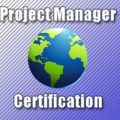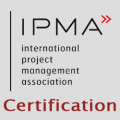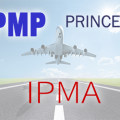
The International Project Management Association (IPMA) maintains a project management methodology and certification scheme which is outlined in the Individual Competence Baseline. This manual outlines 29 ‘competence elements’ which define a competent project manager.
The competence elements are divided into three subcategories:
- Perspective
- People
- Practice.
Perspective
 Strategy
Strategy
This competence element describes how corporate strategy is transformed into manageable elements using projects. The key competence indicators are:- Align with organizational mission and vision
- Identify and exploit opportunities to influence organizational strategy
- Develop and ensure the ongoing validity of the business / organizational justification
- Determine, asses and review critical success factors
- Determine, asses and review key performance indicators
- Governance, structures and processes
The project manager must have a strong understanding of the corporate structure, systems and processes that provide support for the project. The key competence indicators are:- Know the principles of project management and the way in which they are implemented
- Know and apply the principles of programme management and the way in which they are implemented
- Know and apply the principles of portfolio management and the way in which they are implemented
- Supporting functions
- Align the project with human resource processes and functions
- Align the project with finance and control processes and functions
- Compliance, standards and regulations
The project manager must interpret and balance the restrictions in a given country, company, or industry.- Identify and ensure that the project complies with all relevant legislation
- Identify and ensure that the project complies with all relevant health, safety, security and environmental regulations (HSSE)
- Identify and ensure that the project complies with all relevant codes of conduct and professional regulation
- Identify and ensure that the project complies with relevant sustainability principles and objectives
- Assess, use and develop professional standards and tools for the project
- Assess, benchmark and improve the organizational project management competence
- Power and interest
The individual must recognize and understand the informal personal and group interests, as well as the resulting politics and use of power. There are three key competence indicators:- Assess the personal ambitions and interests of other and the potential impact of these on the project
- Assess the informal influence of individuals and groups and its potential impact on the project
- Assess the personalities and working styles of others and employ them to the benefit of the project
- Culture and values
Project managers must be aware of the organization’s corporate culture and values, as well as those of the wider society in which the project operates. The key competence indicators are:- Assess the culture and values of the society and their implications for the project
- Align the project with the formal culture and corporate values of the organization
- Assess the informal culture and values of the organization and their implications for the project
 People
People
- Self-reflection and self-management
Being aware of and reflecting on one’s emotions and values guides our decision making. Competent project managers are aware of their primary reactions and open to the possibility of changing and improving their behavior. The key competence elements are:- Identify and reflect on the ways in which own values and experience affect the work
- Build self-confidence on the basis on personal strengths and weaknesses
- Identify and reflect on personal motivations to set personal goals and keep focus
- Organize personal work depending on the situation and own resources
- Take responsibility for personal learning and development
- Personal integrity and reliability
A person must act in accordance with their own moral and ethical values and principles, which fosters consistent behavior in project management decisions. It supports an environment of trust that makes others feel secure and confident. The key competence elements are:- Acknowledge and apply ethical values to all decisions and actions
- Promote the sustainability of outputs and outcomes
- Take responsibility for own decisions and actions
- Act, take decisions and communicate in a consistent way
- Complete tasks thoroughly in order to build confidence with others
- Personal communication
Effective communication is essential to strong project management. The content of each communication, as well as the means (tone of voice, channel, and amount of information) have to be clear as well as appropriate to the target audience. Formal communication such as presentations, meetings, written forms, etc., must be used according to their value and limitations.- Provide clear and structured information to others and verify their understanding
- Facilitate and promote open communication
- Choose communication styles and channels to meet the needs of the audience, situation and management level
- Communicate effectively with virtual teams
- Employ humor and sense of perspective when appropriate
- Relationships and engagement
The quality of relationships is one of the most important success factors in project management. Both one-to-one relationships as well as a relationship network are important competence elements resulting in high performance. Strong relationships allow for easier engagement, decision making, and leadership.- Initiate and develop personal and professional relationships
- Build, facilitate and contribute to social networks
- Demonstrate empathy through listening, understanding and support
- Show confidence and respect by encouraging others to share their opinions or concerns
- Share own vision and goals in order to gain the engagement and commitment of others
- Leadership
Leadership is important for the project manager throughout the life cycle of a project. There are many different leadership styles available. Which ones, and how they are implemented, are an important driving factor in the steps to project success.- Initiate actions and proactively offer help and advice
- Take ownership and show commitment
- Provide direction, coaching and mentoring to guide and improve the work of individuals and teams
- Exert appropriate power and influence over others to achieve the goals
- Make, enforce and review decisions
- Teamwork
Project teams carry out the project’s technical work and accomplish the project objectives. They often encompass multiple disciplines and personal experiences. Managing the team requires selecting the right team members, keeping them motivated, and giving them the tools to succeed.- Select and build the team
- Promote cooperation and networking between team members
- Support, facilitate, and review the development of the team and its members
- Empower teams by delegating tasks and responsibilities
- Recognize errors to facilitate learning from mistakes
- Conflict and crisis
Conflicts can occur between project team members, stakeholders, or the project manager themselves. How these conflicts are handled can result in positive outcomes or significant, long term negative affects on the project. The project manager must:- Anticipate and possibly prevent conflicts and crises
- Analyse the causes and consequences of conflicts and crises and select appropriate response(s)
- Mediate and resolve conflicts and crises and/or their impact
- Identify and share learning from conflicts and crises in order to improve future practice
- Resourcefulness
Resourcefulness is the application of techniques and ways of thinking to finding alternatives and problem solving. It is utilized when unique problems, difficult situations, and risks occur. Resourcefulness motivates the project team to work together to develop a workable solution to an issue. The project manager must:- Stimulate and support an open and creative environment
- Apply conceptual thinking to define situations and strategies
- Apply analytic techniques to analysing situations, financial and organizational data and trends
- Promote and apply creative techniques to find alternatives and solutions
- Promote a holistic view of the project and its context to improve decision making
- Negotiation
Almost all project require negotiation, between the project team and it customer, the project and its parent organization, or within the project. Because of this, the project manager must be familiar with negotiation strategies and tactics.- Identify and analyze the interests of all parties involved in the negotiation
- Develop and evaluate options and alternatives with the potential to meet the needs of all parties
- Define a negotiation strategy in line with own objectives that is acceptable to all parties involved
- Reach negotiated agreements with other parties that are in line with own objectives
- Detect and exploit additional selling and acquisition possibilities
- Results orientation
The project manager must maintain focus on the end result of the project. All project activities must support this end result, or they should not be part of the project. Likewise, all project decisions must consider how they impact the final project result.- Evaluate all decisions and actions against their impact on project success and the objectives of the organization
- Balance needs and means to optimize outcomes and success
- Create and maintain a healthy, safe and productive working environment
- Promote and ‘sell’ the project, its processes and outcomes
- Deliver results and get acceptance
 Practice
Practice
- Project design
The project design details the processes and steps that the project will take to ensure its success. Aspects such as perceived benefits, team and stakeholder communication are analyzed and planned to ensure project success. The blueprint or overall architecture of the project is laid out and managed. The project must:- Acknowledge, prioritize and review success criteria
- Review, apply and exchange lessons learned from and with other projects
- Determine complexity and its consequences for the approach
- Select and review the overall project management approach
- Design the project execution architecture
- Requirements, objectives and benefits
This competence addresses why the project is being undertaken. Every project produces a product or service, but on a deeper level, those products create a benefit to the organization. The project manager must realize what those benefits are and seek to maximize them.- Define and develop the project goal hierarchy
- Identify and analyze the project stakeholder needs and requirements
- Prioritize and decide on requirements and acceptance criteria
- Scope
The project scope is one of the highest sources of project issues. Scope defines what is part of the project and what is not, and when the boundaries of the project are not well understood – or change without well defined parameters – problems almost always arise. Thus, the project manager must understand, define, and manage the project scope.- Define the project deliverables
- Structure the project scope
- Define the work packages of the project
- Establish and maintain scope configuration
- Time
This competence element includes project scheduling, that is, planning for an acceptable time frame and ensuring that the project deliverables are produced within that time frame. The project must be divided into tasks, and each task must be estimated do determine its duration. During project execution, project control mechanisms are implemented to give the project manager warning of behind-schedule situations, and take appropriate action.- Establish the activities required to deliver the project
- Determine the work effort and duration of activities
- Decide on schedule and stage approach
- Sequence project activities and create a schedule
- Monitor progress against the schedule and make any necessary adjustments
- Organization and information
The project manager must define, implement, and manage the temporary project organization. They must also create the project documentation and storage facilities, reporting structures and project communication flows.- Assess and determine the needs of stakeholders relating to information and documentation
- Define the structure, roles and responsibilities within the project
- Establish infrastructure, processes and systems for information flow
- Implement, monitor and maintain the organization of the project
- Quality
Quality encompasses the whole project, from its planning to the final touches. Quality is about ensuring the right specifications are determined, to ensuring that the products are produced to those specifications.- Develop and monitor the implementation of and revise a quality management plan for the project
- Review the project and its deliverables to ensure that they continue to meet the requirements of the quality management plan
- Verify the achievement of project quality objectives and recommend any necessary corrective and/or preventive actions
- Plan and organize the validation of project outcomes
- Ensure quality throughout the project
- Finance
The project manager must estimate the project during the planning phase, and control the financial expenditures of the project during the execution phase. Also, ensuring the financial resources are in place to complete the project are extremely important to successful project outcomes.- Estimate project costs
- Establish the project budget
- Secure project funding
- Develop, establish and maintain a financial management and reporting system for the project
- Monitor project financials in order to identify and correct deviations from the project plan
- Resources
Defining, acquiring and controlling resources is where a project manager spends most of their day. Resources include people, expertise, facilities, equipment, materials, infrastructure, tools and any other asset required to complete the project tasks. The project manager must:- Develop strategic resource plan to deliver the project
- Define the quality and quantity of resources required
- Identify the potential sources of resources and negotiate their acquisition
- Allocate and distribute resources according to defined need
- Evaluate resource usage and take any necessary corrective actions
- Procurement
Most projects need to purchase (procure) goods, services, or resources to carry out their mandate. The types of contracts to be used, roles and responsibilities, supplier selection processes, and the like, are core to the project managers expertise. The project manager must know how to:- Agree on procurement needs, options and processes
- Contribute to the evaluation and selection of suppliers and partners
- Contribute to the negotiation and agreement of contractual terms and conditions that meet project objectives
- Supervise the execution of contracts, address issues and seek redress where necessary
- Plan and control
The project manager must create a plan for the project, and exercise project control to ensure that the project remains within the plan. The plan is a moving document, updated regularly to ensure it is relevant and progress is sufficient. The key competence indicators are:- Start the project and develop and get agreement on the project management plan
- Initiate and manage the transition to a new project phase
- Control project performance against the project plan and take any necessary remedial actions
- Report on project progress
- Assess, get agreement on and implement project changes
- Close and evaluate a phase or the project
- Risk and opportunity
Project managers must identify and prioritize risks, including the creation of risk response plans and project control during the execution phase. The opposite of risks are opportunities (positive risks) and they should be tracked for potential exploitation as well. - Stakeholders
Stakeholders are anyone who has an interest in the project, whether positive or negative. Stakeholders have expectations that must be managed, otherwise a small stakeholder can often trip up a project. Project managers must identify each stakeholder, and ensure they are familiar with their needs and wants. There needs to be a stakeholder engagement strategy.- Identify stakeholders and analyze their interests and influence
- Develop and maintain a stakeholder strategy and communication plan
- Engage with the executive, sponsors and higher management to gain commitment and to manage interests and expectations
- Engage with users, partners, suppliers and other stakeholders to gain their cooperation and commitment
- Organize and maintain networks and alliances
- Change and transformation
Projects, by definition, attempt to institute some sort of change within an organization. How the organization responds to that change, and how the project manager must manage that change, is the focus of this competence element.- Assess the adaptability to change of the organization(s)
- Identify change requirements and transformation opportunities
- Develop change or transformation strategy
- Implement change or transformation management strategy
- Select and Balance
This final competence element doesn’t apply to project management – only program and portfolio management.






